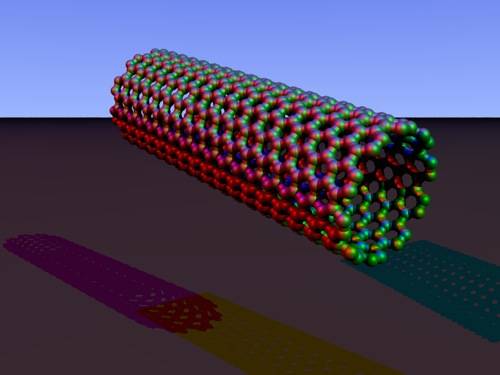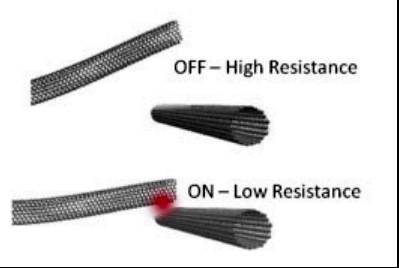This article is more than 1 year old
Flash-killer nanotube memory firm teams with Belgians to try again
3 yrs late, and counting - but now moving 'even faster'
Carbon nanotube memory startup Nantero has inked a deal to develop dense non-volatile memory with IMEC, a Belgian research centre, using its NRAM technology. For those of you who remember, back in 2007, Nantero told The Reg it expected the tech to replace flash by 2009, which seemed over-optimistic at the time. But the new deal could see the dream coming a lot closer to reality.
Carbon nanotubes (CNTs) are cylindrical carbon allotropes, molecules up to a millimetre long but just a nanometer thick, and have a length-to-diameter of up to 132,000,000:1. Their walls are made up of single-atom-thick carbon sheets - graphene. CNTs are members of the fullerene family and their properties include the ability to conduct electricity as well as copper, while being stronger than steel and as hard as diamond.

Carbon nanotube schematic
We first wrote about Nantero in 2003. Its NRAM or Nanotube-based RAM is a non-woven matrix "deposited onto a substrate that contains an underlying cell select device and array lines (typically transistors or diodes) that interface the NRAM switch".
In the matrix the CNTs cross each other and can be either touching or slightly separated depending on their mechanical state. Nantero states:
CNTs in the fabric that are in close proximity come under the influence of Van der Waal's interactions resulting in a strong physical adhesion (Eact ~ 5eV) ... allowing electrical conduction between CNTs. CNTs that are separated beyond the Van der Waals interaction distance remain separated due to the high mechanical (~1 TPa) stiffness (Eact>>5 eV) of the CNTs. Being separated, the CNTs are not in electrical contact and do not conduct electrical current between the separated CNTs.In Nantero's technology, to form a single NRAM "cell", each "cell" consists of a number of CNTs forming a network of interlinked CNTs located between two electrodes with one of the electrodes contacting an underlying device such as a transistor and the other electrode to a signal line such a "Select Line" … The select device and CNT film or fabric located between to the two metal electrodes, which is photolithographically defined and etched, forms the NRAM "cell".

Nantero Carbon Nanotubes
The NRAM acts as a resistive non-volatile random access memory NVRAM and can be placed in two or more resistive modes depending on the resistive state of the CNT fabric. When the CNTs are not in contact the resistance state of the fabric is high and represents a "0" state. When the CNTs are brought into contact, the resistance state of the fabric is low and represents a "1" state.
What causes the NRAM to act as a memory is that the two resistive states of the CNTs are both very stable. In the "OFF" or "0" state, the CNTs or a portion of them … are not in contact and remain in a separated state due to the stiffness of the CNTs resulting in a high resistance or low current measurement state between the top and bottom electrodes. In the "ON" or "1" nonvolatile state of the device, the CNTs or a portion of them are in contact … and remain in a contacted state due to Van der Waals forces between the CNTs resulting in a low resistance or high current measurement state between the top and bottom electrodes.
Read more about NRAM here where there are more diagrams to illustrate the text.
Nantero says its objective is "to deliver a product that will replace all existing forms of memory, such as DRAM, SRAM and flash memory, with NRAM serving as universal memory. The potential applications for the nonvolatile memory Nantero is developing are extensive and include the ability to enable instant-on computers and to replace the memory in devices such as cell phones, MP3 players, digital cameras, and PDAs, as well as applications in the networking arena."
Its NRAM design "involves the use of carbon nanotube-based resistance change elements. Bits are switched between conductive and non-conductive states through the application of write pulses of controlled voltage and current."
Nantero has made 4Mbit arrays of NRAM in CMOS production environments, with write speed as fast as 3 nanoseconds; anticipated unlimited endurance as more than a trillion cycles have been tested, low operating power and good high temperature retention.
IMEC is a nano-electronics and nano-technology research institute headquartered in Leuven, Belgium, and has offices in Belgium, the Netherlands, Taiwan, US, China, India and Japan, and some 2,000 staff. IMEC has this to say about carbon nanotubes:
[They] exhibit extraordinary strength, unique electrical properties and efficient heat conduction, making carbon nanotubes a highly promising material for future memories.
NRAM arrays will be manufactured, tested and characterised in IMEC’s nanoelectronics facilities. Jo de Boeck, IMEC's CTO, said: "Nantero and IMEC can develop and demonstrate this form of memory for future applications below 20nm such as terabit-scale memory arrays and ultra-fast gigabit-scale nonvolatile cache memories. NRAM holds clear promise in aggressively scaled Non-Volatile Memory applications and, if we can demonstrate the suitable endurance and speed specifications, NRAM could even provide an alternative for DRAM that is facing scaling limitations beyond 18nm.”
Greg Schmergel, Nantero’s co-founder and CEO, reckons: "Working with IMEC will … bring carbon nanotube memory to market to move even faster.”
Nantero's technology is a form of resistive RAM and competes with other resistive technologies such as HP's memristor. That and Phase Change Memory are closer to productisation and, despite Natero NRAM's impressive performance numbers, may scoop the post-NAND pool due to being first to market. ®
